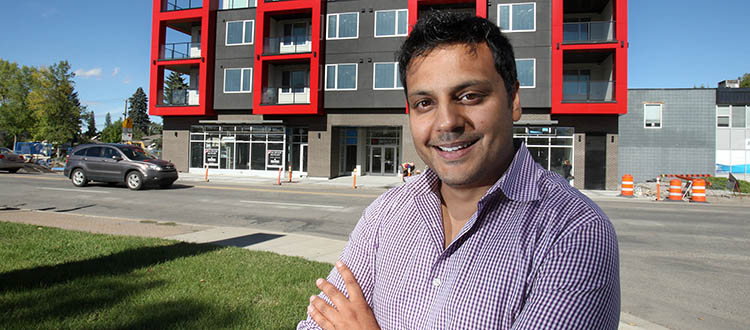
Sept. 23, 2016 | Andrea Cox
The future of infills
City revisiting inner-city developmentAlmost 15 years ago, Naz Virani made the shift from chef to homebuilder and developer. Since then, he has been one of a handful of builders at the fore of Calgary's gentrification.
In the early 2000s, Virani founded Sarina Homes, and began what he describes as a journey to transform the inner-city, one infill home at a time.
"A lot has changed since we started the business," he recalled. "We started out building single-family homes, then moved into semi-detached and then fourplex designs."
But through it all, he said the focus has been on incorporating a model that optimizes density in a smart, considerate way – one that is inclusive of the surrounding community and future development.
"It's really interesting to watch how Calgary is shaping and growing," he said.
"Until we get more feedback from our stakeholders, we really aren't sure of the specific rules that may or may not need to be addressed."
And it might be morphing again as the City of Calgary has embarked on discussions to revisit current contextual land-use bylaws, including how they will relate to future infill development.
It marks the fourth time the City has revisited the bylaws since 2007. Past monitoring by the City has led to changes such as the inclusion of semi-detached dwellings and modifications to height calculations on corner-lot buildings.
"Until we get more feedback from our stakeholders, we really aren't sure of the specific rules that may or may not need to be addressed," said City of Calgary planner Tammy Henry.
The fourth report, which will incorporate feedback from a series of open houses, is currently in the works, and will be submitted to council for review by the end of this year.
Virani, for one, believes revisiting the bylaws is good news for the industry.
"The City has really taken the lead by collaborating with and engaging industry," he said. "They really don't get enough credit. At the end of the day, we are all in this together."
An infill is a loosely defined term, but Federation of Calgary Communities urban planner Dan Godin wraps it up as, "a short-hand term used for a new building and development that happens on undeveloped land in built up areas of the city – or, as in many Calgary communities, the replacement of older buildings with new development on the same parcel."
Henry added a contextual design (one that is zoned RC) is sensitive to the surrounding housing stock with defined height and location restrictions and parameters.
"In our land bylaw, we have permitted uses (contextual designation) which are by right. There are also properties designated discretionary uses, which involve more of a rigorous process," said Henry.
Godin noted infill evolution throughout Calgary's landscape has been significant. Along century-old tree-lined streets in multiple neighbourhoods within a short jaunt of the city's core, svelte two- and three- story contemporary, flat-roofed designs are replacing 1940's, '50's and '60's bungalows – and, in the process, redefining communities' very fabric.
Sarina Homes was one of the first builders in Calgary to design the quad-style fourplex, a side-by-side semi-detached plan with homes in the front and back. It's a design (along with the semi-detached home) that has sculpted inner-city neighbourhoods on both the north and south sides of the city from Marda Loop to Killarney and Kensington.
Virani said in developed communities, the table is pretty much set.
"The infrastructure is in place. It's here that the focus really comes down to streamlining the process," he said.
The City's regulations as they relate to infill development do not touch upon home design attributes, but Godin offers a few suggestions.
"I don't think that there is a one-size-fits-all approach, but good communication with the community early in the process can help infill developers and builders understand the community context, which can, in turn, improve the fit in older communities," he said.
For more information about future changes to Calgary's land-use bylaw, including contextual design regulations, email engageinplanning@calgarycommunities.com.
Tagged: Calgary Real Estate | Calgary Real Estate News | City of Calgary | developer | federation of Calgary communities | homebuilder | Housing Market | infills | Inner City | land-use | neighbourhoods | urban planner | YYCRE




